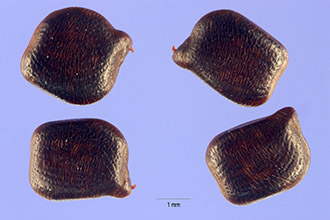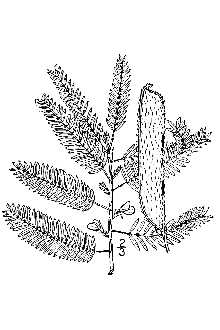Sensitive Partridge Pea
Scientific Name: Chamaecrista nictitans (L.) Moench

| General Information | |
|---|---|
| Usda Symbol | CHNI2 |
| Group | Dicot |
| Life Cycle | AnnualPerennial, |
| Growth Habits | Forb/herbSubshrub, |
| Native Locations | CHNI2 |
Plant Guide
Alternate Names
Common Names: partridge pea; sensitive plant; sensitive cassia; sleeping plant Scientific Names: Cassia nictitans L.; Cassia aeschynomene DC. ex Collad; Cassia lechenaultiana DC
Description
General: Sensitive partridge pea is an annual, herbaceous, leguminous plant, It grows 4–20 in (10–50 cm) tall on multiple stems and has a well-developed taproot, The hairless stems and branches have persistent 4–7 mm long lance-shaped, pointed bristles (stipules), The 3–6 cm long oblong leaves are alternatively arranged, sensitive to movement if you touch them, and have a small spine at the tip, The leaf may have 25 leaflets, The 4–9 mm long leaf petiole is covered with short, fine hairs, and has a single petiolar gland located beneath the lowest pair of leaflets, It produces yellow flowers with irregular (zygomorphic) flower petals characteristic of the Caesalpinioideae subfamily of Leguminosae, The 5 petals are all distinct, are approximately 1,5 cm wide, and grow where the leaf and stem meet, Use soil moisture sensors to measure the soil moisture of Sensitive Partridge Pea., The stamens are separate, and the hairless filaments are not united, The oblong, elongate fruit is a single-chambered legume that explosively splits along one seam, Seeds are smooth and brown or black in color, Distribution: Sensitive partridge pea is native to the United States, Mexico, parts of South and Central America, and is naturalized in the tropics and subtropics of Asia (Cook et al,, 2005), It grows along the East Coast from Maine to Florida, west to Arizona, and north to Wisconsin, It is endangered in New Hampshire (Magee and Ahles, 1999), For current distribution, please consult the Plant Profile page for this species on the PLANTS Web site, Habitat: Sensitive partridge pea can be found near rivers or ponds, in woods, prairies, thickets, and along roadsides, It is common in disturbed sites in the eastern US (Cook et al,, 2005), It is often found in the pine savannas and woodlands of the southern US, It will grow in association with native grasses such as little bluestem (Schizachyrium scoparium) and Indiangrass (Sorgastrum nutans); however once a canopy develops sensitive partridge pea tends to die out (Leck and Leck, 2005),
Adaptation
Sensitive partridge pea is classified as a USDA facultative upland plant that most often occurs in non-wetlands. It is adapted to sandy soils (Magee and Ahles, 1999). It was found growing in association with little bluestem (Schizachyrium scoparium), devil’s-tongue prickly pear (Opuntia humifusa), and white-haired panic grass (Dichanthelium villosissimum) in the dry sand prairie habitat of Northern Illinois (Phillippe et al., 2008).
Uses
Forage/hay: Generally these species are slow-growing, low-yielding, slow to decompose, and may have some toxicity, so are not always desired for grazing (Allen and Allen, 1981). However, sensitive partridge pea has been used as forage or hay in infertile subtropical soils (Cook et al., 2005). Its erect habit enables easy harvesting for cut-and-carry systems. Hay should be cut at first flowering to preserve its nutritive quality. Sensitive partridge pea is also foraged by goats (Cook et al., 2005). Cover crop: The roots of sensitive partridge pea are able to nodulate although its capability to nodulate is relatively low compared to the Mimosoideae (Mimosa; Acacia) and Faboideae (soybean; pea; peanut; wild indigo) (Naisbitt et al., 1992). It has branching nodulation with determinate nodule structure (Saur et al., 2000). In a study comparing native legume species in a longleaf pine–wiregrass system, sensitive partridge pea had one of the greatest biomass results and highest overall tissue N content of the nine species tested. This finding suggests that partridge pea can help build the N pool, soil organic matter, and increase N availability in some natural ecosystems. The N2 fixation activity was not different between shaded and non-shaded treatments (Cathey et al., 2010). Natural Resources Conservation Service Plant Guide Wildlife: Sensitive partridge pea is eaten by eastern mourning dove, eastern meadow lark, eastern turkey, and bobwhite (Graham, 1941). Sensitive partridge pea has extrafloral nectaries that attract ants, spiders, and pollinators. A study by Ruhren (2003) found that increasing partridge pea patch size leads to greater amounts of ants and parasitoid wasps while reducing the number of insect herbivores. In another study by Ruhren and Handel (1999) the researchers found that sensitive partridge pea also attracted jumping spiders that helped increase fruit and seed production. Sensitive partridge pea has been used in pollinator habitat seed mixes in DOT roadside plantings. It is the larval plant for the little sulphur and cloudless sulphur; and recommended for use in monarch habitat plantings (NCNPS, 2013).
Ethnobotany
The eastern band of Cherokee Indians used sensitive partridge pea in combination with Cassia marilandica to treat spasms in infants (Cozzo, 2004).
Status
Weedy or Invasive: Because partridge pea is a reseeding annual it may spread to nearby fields, especially where competition is removed. Please consult with your local NRCS Field Office, Cooperative Extension Service office, state natural resource, or state agriculture department regarding its status and use. Please consult the PLANTS Web site (http://plants.usda.gov/) and your State Department of Natural Resources for this plant’s current status (e.g., threatened or endangered species, state noxious status, and wetland indicator values).
Planting Guidelines
Plant scarified seeds in late spring–early summer in a well-prepared seedbed in full sun. The seed does not require inoculation, and will use native rhizobia already present in soil (Cook et al., 2005). Plant approximately 10 lb/ac at ¼ – ¾ inches deep. It may be planted in a seed mix for hay or forage, but its ability to reestablish itself from seed will be limited by competition. Stronger stands can be produced through reseeding each year. The USDA-NRCS recommends planting 1.5 lb/ac seed or 6% of a native wildflower mix to attract monarch butterflies (USDA-NRCS, 2015a).
Management
Over time, stands of sensitive partridge pea will become invaded by grasses and weeds. These grasses can be mowed off, and the fields lightly disked in fall to clear residue, open up the soil, and incorporate fall-produced seed.
Seeds and Plant Production
Plant Production
Plant Production
Sensitive partridge pea is a reseeding annual that flowers from July–September (Cook et al., 2005). The seeds require scarification for good germination. Sensitive partridge pea had a maximum germination rate under wet heat (boiling water) at 70–80°C (Bolin, 2009). Seedlings are fast growing and may bloom within 6 weeks (Cook et al., 2005). It is a C3 species that can show strong responses to elevated atmospheric CO2 levels by responding negatively with lower rates of branching, height, and leaf formation (Millhollen et al., 2006; Matiella, 2009). It can produce 5–30 lb/ac/yr biomass in longleaf pine/wiregrass/bluestem plant communities (USDA-NRCS, 2015b). There are approximately 455 seeds/g (Cook et al., 2005) Cultivars, Improved, and Selected Materials (and area of origin) There are no known developed plant materials. Consult with your local land grant university, local extension or local USDA NRCS office for recommendations on adapted cultivars for use in your area.
Literature Cited
Allen, O.N., and E.K. Allen. 1981. The Leguminosae: a source book of characteristics, uses, and nodulation. The Univ. of Wisc. Press. Madison, WI. Bolin, J.F. 2009. Heat shock germination responses of three eastern North American temperate species. Castanea 74(2):160–167. doi: http://dx.doi.org/10.2179/08-010.1 Carino, D.A., and C.C. Daehler. 2002. Can inconspicuous legumes facilitate alien grass invasions? Partridge peas and fountain grass in Hawai‘i. Ecography 25:33–41. Cathey, S.E., L.R. Boring, and T.R. Sinclair. 2010. Assessment of N2 fixation capability of native legumes from the longleaf pine-wiregrass ecosystem. Environ. Exp. Bot. 67(3):444–450. Cook, B.G., B.C. Pengelly, S.D. Brown, J.L. Donnelly, D.A. Eagles, M.A. Franco, J. Hanson, B.F. Mullen, I.J. Partridge, M. Peters, and R. Schultze-Kraft. 2005. Tropical forages: an interactive selection tool. Chamaecrista nictitans. CSIRO, DPI&F(Qld), CIAT, and ILRI, Brisbane, Australia. http://www.tropicalforages.info/key/Forages/Media/Html/Chamaecrista_nictitans.htm (accessed 03 Mar. 2015). Cozzo, D.N. 2004. Ethnobotanical classification system and medical ethnobotany of the eastern band of the Cherokee Indians. Ph.D. Dissertation. Anthropology Dept., Univ. GA. Graham, E.H. 1941. Legumes for erosion control and wildlife. USDA–SCS Misc. Pub. # 412. U.S. Gov. Print Office, Wash. D.C. Leck, M.A., and C.F. Leck. 2005. Vascular plants of a Delaware River tidal freshwater wetland and adjacent terrestrial areas: seed bank and vegetation comparisons of reference and constructed marshes and annotated species list. J Tor. Bot. Soc. 132(2): 323–354. doi: http://dx.doi.org/10.3159/1095-5674(2005)132[323:VPOADR]2.0.CO;2
Conservation
District at http://www.nrcs.usda.gov/ and visit the PLANTS Web site at http://plants.usda.gov/ or the Plant Materials Program Web site: http://plant-materials.nrcs.usda.gov. PLANTS is not responsible for the content or availability of other Web sites.

